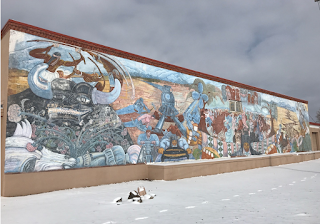I thought I would finally get some time off and could post some repeats considering practically every art institution is closing everywhere, even the Tate in London, which at first boasted that it would stay open after many were closing is now shut.
Though I knew that some museums were trying to remain open on line I did not realize how prevalent this was until I got the email, “The Ultimate Guide to Virtual Museum Resources, E-Learning, and Online Collections”. It lists something like 110 different art sites that one can visit and many of those have multiple sites listed. That should keep the homebound busy!
There are even discoveries that specialists can make. Just one example is a former museum director who has spent his retirement studying Native American ceramics and written several books on the subject. He saw on line an image of a vitrine full of such ceramics and reported, “I never knew that the Pitts River Museum at Oxford College, England had so many Native American ceramics.”
As you may have heard The European Art Fair (TEFAF) that takes place in Maastricht, closed shortly after it opened. Next thing I knew all the dealers were sending me virtual tours of their booths. Here is one from friends of ours based in Munich, Germany, The Arnoldi-Livie Gallery. You can move your cursor to get different angles or hit one of the little circles to get a closer look at a single work: https://vrbox.io/tour/5e61535d4cb58doc161807017
Go to the site of The Uffizi in Florence, a museum like no other in Italy, and look at their collection. Page one has Caravaggio’s Bachus and Botticelli’s Spring and put in an artist’s name in the search box for any artist you desire. Entering Raphael or Michelangelo will also lead to fabulous results. If you wish, click on the image you can get further details about the work: https://www.uffizi.it/en/the-uffizi
 |
| Piero della Francesca, The Duke and Duchess of Urbino |
I have never visited The Frick Pittsburg although Miss Helen Clay Frick was a very good client of ours, and, by the way, a very gracious lady. She was the daughter of the American industrialist, financier, union-buster, and art patron who was from Pittsburgh, Pennsylvania. Miss Frick turned the historic family home into a museum in which she wished to emulate the Frick Collection in New York. Through the tour on its website, I got to see a Rubens, a couple of tapestries and a French 18th-century gueridon table with Sevres plaque and candle holders which we sold to Miss Frick: https://www.thefrickpittsburgh.org/virtualam
 |
| Peter Paul Rubens, Marguerite de Montmorency, Princess of Condé |
There are many specialized collections, for instance, musical instruments. Click on: https://mimo-international.com/MIMO for the world’s largest archive of musical instruments registering over 64,000 items!
I am sorry, I did not realize that your interest was in trains. Then please visit The Railroad Museum of Pennsylvania: https://rrmuseumpa.org/about/musviews. For me, it brought back childhood memories. I remember going to camp on an overnight sleeper train… no one slept! James, the husband of my nanny Evelyn, was a short-order cook on the Pennsylvania Railroad and she was a great cook too. That is where I acquired my “culinary skills” and still enjoy a quickly cooked meal on a stovetop best. In fact, in my teenage years, I once cooked a several course meal for a group of friends on a single electric skillet!
There are links to National Parks and sites for kids, many coming from art museums, digital libraries, science and history sites and all kinds of collections but let me go back for one more art site.
How about The Walker Art Center in Minneapolis, one of this country’s best repositories for modern art https://walkerart.org/collections. I am illustrating a self-portrait by Chuck Close from their collection. Why Chuck Close? First of all, I love his work, and then for more personal reasons. He was a genuinely nice guy, one could call him a “mensch”! We had kids at the same school and he was represented by Pace Gallery, which was in the same 57th Street building as Rosenberg & Stiebel. He even joined us for the luncheon at our gallery celebrating the opening of Stiebel Modern, (the contemporary branch which we had for 5 years).
 |
| Chuck Close, Self Portrait, Yellow Raincoat |
To me, it is obvious that art dealers should go online. Some artists represented by contemporary galleries, however, don’t want their art to be sold in the same way as from Amazon, even if the income is much needed.
I just hope that people do not get so used to looking at pictures online that they fail to visit the real thing when this is all over. Somehow, I don’t think they will. On another level, even if you cannot own a Leonardo da Vinci, you can bookmark one in a museum that you can call your own!
As a final act of goodwill, today, I will give away my source where you can enjoy all this research: http://mcn.edu/a-guide-to-virtual-museum-resources ... ENJOY!
PS: I do not usually put responses to my missives but this one that I received from Richard (Dick) Stolley Reporter and Bureau Chief at Life Magazine, Founding Editor of People Magazine and Senior Editorial Advisor at Time, Inc. seemed particularly important for the present situation in our country.
When I wrote last week I about The Art of Lying, Dick responded:
“As journalists, we are forbidden to lie, and most of us try to follow that Fourth Estate Commandment. It's not always possible sometimes because we don't have the right information when we put pen to paper (so to speak). So the real commandment is NEVER stop reporting. Therein lies whatever Truth exists.”

















